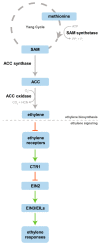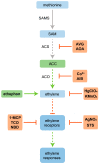Modulation of Organogenesis and Somatic Embryogenesis by Ethylene: An Overview
- PMID: 34198660
- PMCID: PMC8232195
- DOI: 10.3390/plants10061208
Modulation of Organogenesis and Somatic Embryogenesis by Ethylene: An Overview
Abstract
Ethylene is a plant hormone controlling physiological and developmental processes such as fruit maturation, hairy root formation, and leaf abscission. Its effect on regeneration systems, such as organogenesis and somatic embryogenesis (SE), has been studied, and progress in molecular biology techniques have contributed to unveiling the mechanisms behind its effects. The influence of ethylene on regeneration should not be overlooked. This compound affects regeneration differently, depending on the species, genotype, and explant. In some species, ethylene seems to revert recalcitrance in genotypes with low regeneration capacity. However, its effect is not additive, since in genotypes with high regeneration capacity this ability decreases in the presence of ethylene precursors, suggesting that regeneration is modulated by ethylene. Several lines of evidence have shown that the role of ethylene in regeneration is markedly connected to biotic and abiotic stresses as well as to hormonal-crosstalk, in particular with key regeneration hormones and growth regulators of the auxin and cytokinin families. Transcriptional factors of the ethylene response factor (ERF) family are regulated by ethylene and strongly connected to SE induction. Thus, an evident connection between ethylene, stress responses, and regeneration capacity is markedly established. In this review the effect of ethylene and the way it interacts with other players during organogenesis and somatic embryogenesis is discussed. Further studies on the regulation of ERF gene expression induced by ethylene during regeneration can contribute to new insights on the exact role of ethylene in these processes. A possible role in epigenetic modifications should be considered, since some ethylene signaling components are directly related to histone acetylation.
Keywords: S-adenosylmethionine; ethylene biosynthesis; ethylene inhibitors; in vitro culture; plant hormones; stress responses.
Conflict of interest statement
The authors declare no conflict of interest. The funders had no role in the design of the study; in the collection, analyses, or interpretation of data; in the writing of the manuscript, or in the decision to publish the results.
Figures



References
-
- Kumar N., Reddy M.P. In vitro plant propagation: A review. J. For. Sci. 2011;27:61–72.
-
- Phillips G.C., Garda M. Plant tissue culture media and practices: An overview. Cell. Dev. Biol. Plant. 2019;55:242–257. doi: 10.1007/s11627-019-09983-5. - DOI
-
- Bhatia S., Bera T. Somatic embryogenesis and organogenesis. In: Bhatia S., Sharma K., Dahiya R., Bera T., editors. Modern Applications of Plant Biotechnology in Pharmaceutical Sciences. Academic Press; Cambridge, MA, USA: 2015. pp. 209–230. - DOI
-
- Biddington N.L. The influence of ethylene in plant tissue culture. Plant Growth Regul. 1992;11:173–187. doi: 10.1007/BF00024072. - DOI
Publication types
Grants and funding
- PhD Fellowship to Mariana Neves 2020.05137.BD/Fundação para a Ciência e a Tecnologia
- PTDC/BAA-AGR/32265/2017, project BP4BP - Tamarillo breeding: better plants for better products/P2020 COMPETE
- (CENTRO-01-0145)/ReNATURE project
- UIDB/04004/2020, financed by FCT/MCTES through national funds (PIDDAC)/Fundação para a Ciência e a Tecnologia
LinkOut - more resources
Full Text Sources

